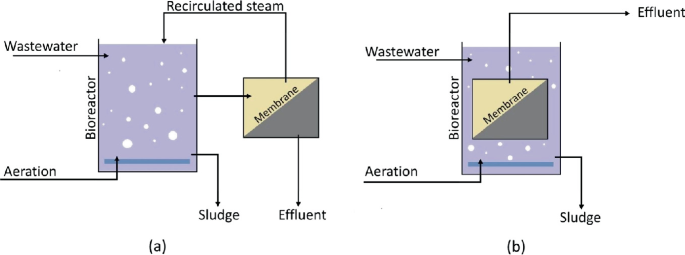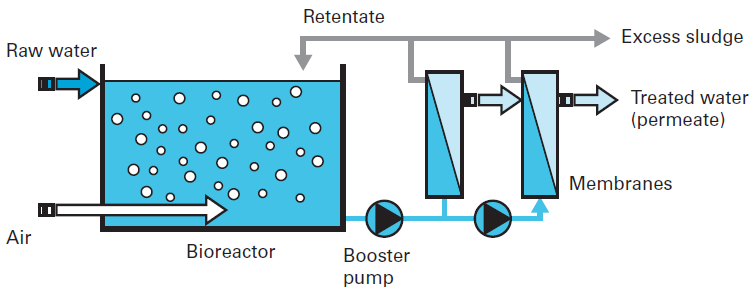The Benefits of Membrane Layer Bioreactors in Sustainable Wastewater Administration
Membrane layer bioreactors (MBRs) represent a pivotal development in lasting wastewater administration, efficiently combining biological treatment with sophisticated membrane layer purification innovation. This integration not only improves effluent high quality by successfully eliminating pollutants yet additionally opens up opportunities for water reuse in various applications, therefore attending to journalism demand for source conservation. The small layout of MBRs contributes to considerable decreases in environmental impact and operational costs. As the need for lasting solutions heightens, discovering the multifaceted benefits of MBRs may expose unforeseen ramifications for the future of wastewater treatment systems.
Introduction of Membrane Layer Bioreactors
Membrane bioreactors (MBRs) stand for a substantial advancement in wastewater therapy modern technology, incorporating organic destruction with membrane layer filtering to boost the performance of the therapy procedure. This innovative system integrates the advantages of conventional turned on sludge procedures with membrane layer technology, enabling for enhanced solid-liquid separation. MBRs make use of semi-permeable membrane layers to different cured water from biomass, causing top notch effluent that can be recycled or securely discharged right into the environment.
The functional design of MBRs normally entails a bioreactor where microbes damage down raw material, complied with by a membrane layer device that filterings system the combined liquor. This arrangement not just minimizes the footprint of the therapy center yet additionally enables greater biomass concentrations and decreased hydraulic retention times. MBRs are capable of treating a broader array of pollutants, including pathogens and nutrients, making them ideal for various applications, from municipal wastewater treatment to industrial effluent processing.
The assimilation of MBRs into wastewater management systems is indicative of a growing trend in the direction of lasting and efficient techniques in ecological design. Their ability to produce high-grade effluent while lessening room demands settings MBR technology as a principal in contemporary wastewater therapy services.
Boosted Effluent Top Quality

The membrane layer filtration process acts as a physical obstacle, making it possible for the retention of microorganisms and particulate issue, which adds to a more clear and cleaner effluent (Membrane Bioreactor). Furthermore, MBRs operate at higher biomass focus than traditional turned on sludge systems, advertising extra effective biodegradation of contaminants. This leads to a reduction in biochemical oxygen need (BOD) and complete suspended solids (TSS) levels in the last effluent
In addition, MBRs show exceptional performance in treating tough wastewater make-ups, such as commercial effluents and wastewater with high nutrient lots. Because of this, the effluent generated is usually of better, enabling even more versatile disposal options and reduced ecological influence. Eventually, the enhanced effluent high quality accomplished through MBR innovation underscores its important role beforehand sustainable wastewater management practices.
Water Reuse Opportunities
The top quality effluent created by membrane layer bioreactors (MBRs) opens up considerable possibilities for water reuse in numerous applications. MBRs efficiently eliminate impurities, including virus, put on hold solids, and organic matter, leading to cured water that fulfills or exceeds regulatory requirements for reuse. This high quality enables the execution of water reusing initiatives across diverse sectors.
One popular application is in agriculture, where treated wastewater can be used for irrigation, promoting sustainable farming methods while saving freshwater sources. Furthermore, MBR-treated effluent can be made use of for commercial procedures such as air conditioning, cleansing, and as a process water source, substantially minimizing the need for drinkable water in these operations.
In metropolitan atmospheres, MBRs help with making use of reclaimed water for landscape irrigation, toilet flushing, and various other non-potable usages, adding to the general durability of water system systems. The assimilation of MBR innovation in decentralized systems aids in managing local water demands, particularly in water-scarce areas.
Minimized Environmental Impact
How can the fostering of membrane layer bioreactors (MBRs) contribute to a lowered environmental influence in wastewater management? MBRs substantially enhance the therapy effectiveness of wastewater while minimizing eco-friendly disturbances. Membrane Bioreactor.
Moreover, MBRs run at lower hydraulic retention times contrasted to standard systems, resulting in smaller sized therapy plant footprints. This small style reduces land usage, thereby protecting all-natural environments and biodiversity. The process also produces much i thought about this less sludge than traditional techniques, alleviating disposal obstacles and decreasing greenhouse gas discharges related to sludge monitoring.
Additionally, MBRs help with the healing of useful sources, such as water and nutrients, adding to a round economy. By allowing water reuse for irrigation or commercial procedures, MBRs aid relieve freshwater scarcity, thus promoting sustainable water use practices. Eventually, the adoption of MBR innovation represents a considerable stride towards lessening the environmental effect of wastewater administration systems.
Economic Advantages of MBRs

Furthermore, MBRs help with the production of premium effluent, which can be reused for different applications, such as agricultural irrigation and commercial processes - Membrane Bioreactor. This reuse capacity can considerably decrease water purchase prices, providing an economic reward for markets dealing with stringent water regulations
The portable style of MBR systems likewise results in reduced land needs, which is specifically useful in metropolitan areas where property is expensive. By reducing room, click markets and municipalities can minimize land purchase and maintenance expenditures.
Additionally, MBRs typically require much less regular maintenance and have a longer life-span than standard systems, further adding to cost financial savings. In recap, the economic benefits of MBRs-- ranging from minimized operational prices to land cost savings and effluent reuse-- make them an engaging option for lasting wastewater administration, offering both instant and long-term economic benefits.
Final Thought
Membrane layer bioreactors represent a transformative technique to sustainable wastewater management, integrating organic treatment with innovative membrane purification for superior effluent high quality. Their ability for reliable contaminant removal assists in water reuse, thereby conserving crucial freshwater sources. In addition, MBRs add to decreased ecological influences via compact designs and lower sludge generation. Economic advantages additionally boost their viability, making MBRs a promising service for addressing the challenges of wastewater therapy and promoting sustainable resource management.
Membrane bioreactors (MBRs) represent a pivotal innovation in lasting wastewater monitoring, successfully combining biological treatment with sophisticated membrane layer filtration technology.Membrane bioreactors (MBRs) stand for a substantial improvement in wastewater treatment technology, incorporating organic deterioration with membrane purification to boost the effectiveness of the treatment procedure.Accomplishing enhanced effluent quality is one of the most substantial advantages of utilizing membrane bioreactors (MBRs) in wastewater therapy.Furthermore, MBRs demonstrate superb efficiency in treating tough wastewater structures, such as industrial effluents and wastewater with address high nutrient lots.Integrating membrane layer bioreactors (MBRs) into wastewater management not just reduces ecological effect but additionally provides substantial economic benefits.